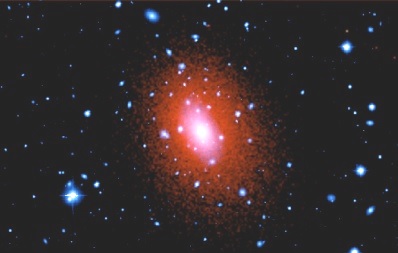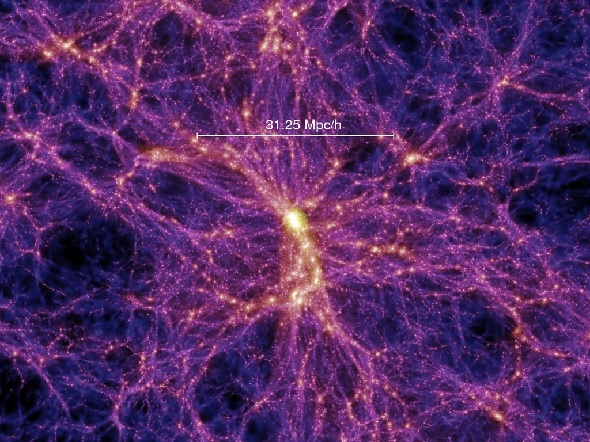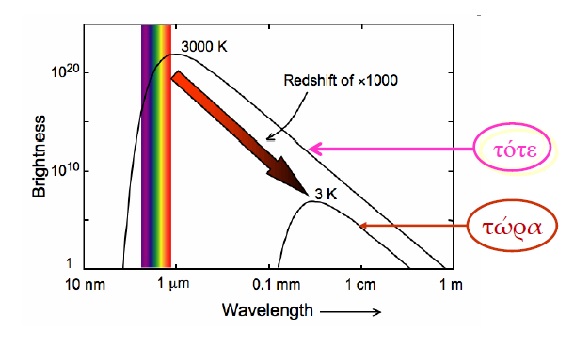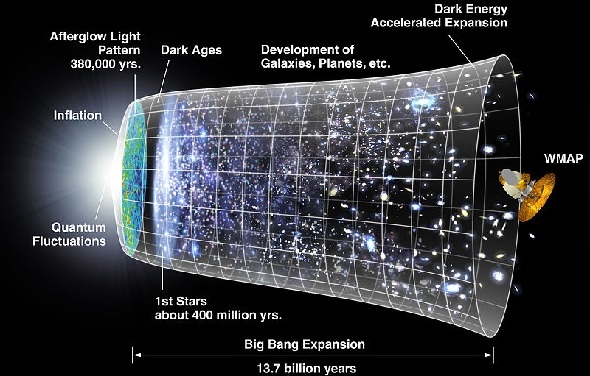It’s astonishing how, in our own day and age, the description of the Creation in Holy Scripture has come to coincide with that of modern science. Especially as regards the initial period, where the contributory science is only physics, the scientific description is consistent, even down to the details, with the description in Genesis concerning “day one”, though this is a text written more than 3,500 years ago. And it’s even more remarkable that this agreement began to become apparent only after 1920. Until then, science believed that the universe had no beginning. It was only after 1963 that a beginning for the universe started to become accepted. And in recent years (end of 20th- beginning of the 21st centuries) the age of the universe has been measured and has been found to be about 13.8 billion years.
Since I shall be saying a lot about this unique day one, let us begin with the wonderful Scriptural description.
“In the beginning, God created the heavens and the earth. The earth was without form and void, and darkness was over the face of the deep. And the Spirit of God was hovering over the face of the waters. And God said, “Let there be light,” and there was light. And God saw that the light was good. And God separated the light from the darkness. God called the light Day, and the darkness he called Night. And there was evening and there was morning, the first day (Gen.1, 1-5).
So nothing pre-existed. Time, as understood by our science, was created and started running with “in the beginning”. During the creation of the angels, which certainly preceded, there was probably no time as we conceive of it today. There would have been another kind of time, though. But the Lord Jesus was “begotten from the Father before all ages”. Before any kind of time was created and began running, the Son was begotten- not made.
But space (the heavens) also started to be created “in the beginning”. The image we have of space today began from General Relativity and the research of those pictured in Fig.1. Later, I shall try to explain their work, which was named the Big Bang theory. Before doing so, however, I should like to stress that the creation of primitive matter and energy occurred at the same time as that of space. Matter and energy are one and the same in General Relativity. So when we talk about matter, we simultaneously mean energy. The heavens, then, in Holy Scripture, is space and (in the interpretation which we shall follow in this article), primitive matter-energy is the unformed earth. Both of these were created together, in the beginning.
In the Big Bang, what explodes and created through the explosion, is space. In the beginning, the whole space of the universe was an infinitesimally small speck, within which all the matter-energy was gathered, with tremendous density and pressure. Suddenly, at time zero[1], the various parts of the speck began separating out and the speck expanded. In the beginning, very violently, later less so. Even today, this initial tiny speck, which now has reached enormous dimensions, continues to grow and the universe is expanding. And we can see and measure it.
The whole phenomenon is extremely unstable, like balancing a pencil on the edge of a table. If you just touch it, it falls. If the initial density values of matter-energy or of pressure deviate just slightly from the ones desired, it would be impossible to create a space that lasted at least as long as ours has. And even if, at the start, some space had been created, these minute differences would have quickly forced it to begin to contract, so that it would again have been reduced to an infinitesimally small speck, as it was initially. The universe would have died without managing to acquire stars or to support life.
Figure 2. Planet Earth
But space in our universe survived. At least we know that it has survived for 13.8 billion years and has managed to support human life.But before proceeding to an interpretation of the Scriptural description, let’s see, in pictures, some of the characteristic features of our universe. First, planet Earth (Fig. 2) It has a radius of some 6,000 kilometres, which is about 100 times less than that of the Sun. From a distance, our Earth looks like a beautiful, blue speck. Generally, the planets revolve around stars (such as the Sun), forming planetary systems. The planetary systems have a tendency to form galaxies. Since the planets don’t have their own light and their masses are generally negligible, only stars (Suns) appear in pictures of galaxies. Figure 3 shows our own galaxy, as it would be seen by an observer who was outside it. The different specks represent stars-suns, gases and dust. On this scale, the planets aren’t apparent. Our sun is indicated with the yellow arrow.
Figure 3. Our Galaxy (Milky Way) and Sun.
[1] For the measurement of time, we’ve used the clock incorporated in General Relativity.
Part II
Our galaxy has a diameter of about[1] 100 kly. Light takes about 8 minutes to reach us from the Sun, but needs about 24,000 years to go from the Sun to the centre of our galaxy. The centre of our galaxy is the colour of snow because of the congestion of bright stars in the region.
The whole of the visible matter in the galaxies consists of nuclei and electrons, such as those we encounter in familiar atoms. We call this matter Known Matter. When we observe pictures of galaxies, we can estimate their mass and, from this, the force of the gravity holding them together. In every case, we can tell that the masses of the galaxies we see aren’t sufficient to sustain them. Under normal circumstances, then, there shouldn’t be any galaxies. The fact that they do exist, however, compels us to accept that they contain other matter, which our telescopes are unable to observe (at least directly). This matter must be of an entirely new form. It can’t be the known matter we referred to above. We call this Dark Matter.
The Abell 2029 cluster of galaxies
But the galaxies, too, tend to appear in groups which are called clusters. Figure 4 shows the Abell 2029 cluster of galaxies, which is 1 billion light years away. The blue specks are galaxies here. The red areas are masses of hot gases of millions of degrees and can be seen through X-rays. Again, the observable known matter isn’t sufficient to sustain such a cluster. In general, the dark matter in the universe must be about five times that of known matter.
5. The Cosmic Web
On an even larger scale, the universe resembles a sponge of cosmic dimensions, which is known as the cosmic web. Figure 5 shows a computer simulation of the cosmic web in a typical region of the universe, equal to about one twenty-fifth (1/25) of the whole of the perceptible universe. The yellow specks here denote clusters of galaxies and the accompanying clouds of gases, while the lilac specks represent dark matter. The black regions (which correspond to the holes in a sponge) indicate enormous vacuums. These are separated by surface structures (like the surfaces that separate the holes of an actual sponge) and are traversed by filaments. All the matter in the universe is gathered in these surface and filament structures. The horizontal white line in the picture represents a length of some 145 million light years and thus is an indication of the scale.
This, then, is the universe we are talking about. Only 5% of the energy which exists in it today comes from known matter. The dark matter we mentioned above, constitutes about 27% of the whole of today’s energy. Therefore the total energy of the universe, known and dark, contributes (5+27)% = 32% of all its energy. The remaining 68% seems not to have material form. It appears to come from the mere vacuum, which also has energy (and pressure). This is called Dark Energy.
As time passes and the universe gets bigger, the total matter disperses and the percentage of energy which it contributes to the energy of the universe decreases. Because of this, the percentage of energy contributed by the vacuum increases correspondingly.
We quoted above the Scriptural description of “day one”, and gave some general information concerning the components of the universe. Hereafter we shall attempt to set out the two descriptions in parallel.
“In the beginning, God created the heavens and the earth. The earth was without form and void, and darkness was over the face of the deep. And the Spirit of God was hovering over the face of the water”. As space expanded, the initial energy-matter changed forms very rapidly. The temperature, which was enormous in the beginning, fell continually. At first, very quickly. Later, more slowly. A whole host of particles (like those we encounter in modern accelerators) were then being produced and almost immediately decayed[2]. Soon after the first twenty minutes, the known matter of the universe consisted only of nuclei of hydrogen, helium, and traces of some other light elements, as well as of electrons and neutrinos[3]. Oxygen nuclei would come much later. Of course, the dark matter mentioned above must be added to the total matter of the universe.
This, then, was the unformed earth. And water was also unformed, since there was no oxygen yet. There were not even hydrogen atoms. Only hydrogen nuclei which were unable to bind the electrons, because of the high temperature.
The existence of free electrons and nuclei made the universe opaque. Moses describes this opaque universe as dark : and darkness was over the face of the deep. And the Spirit of God was hovering over the face of the waters. And he was right, because this universe could not transmit light. The most ancient light we have ever been able to see is that which shone a little later, when the universe became transparent.
And God said: “let there be light; and there was light”. The universe was opaque for about the first 380,000 years. But when it had reached that age, the temperature fell to about 3,000 degrees Kelvin, allowing the light nuclei mentioned above to bind the electrons, forming neutral atoms. Then, more or less suddenly, the universe became transparent and was inundated with light. A blinding light which came from all sides, with almost the same intensity from all directions. It was like the light of noonday in the summer, where all around radiates and is burning. So the day began without a dawn! It began from midday. I do not know which of the Fathers of the Church first said this, but Saint Nikodimos the Athonite knew it and wrote: “for in this the light became not from the morning but began from midday, according to the Theologians” (ΓΥΜΝΑΣΜΑΤΑ ΠΝΕΥΜΑΤΙΚΑ εἰς τήν Ἀνάστασιν τοῦ Κυρίου, Μελέτη ΛΒ΄, α΄, σ. 273, Εκδοση 7η Βασ. Ρηγόπουλου, Θεσσαλονίκη 1991. I’m indebted to G. Takaridis for this quote).
[1] 1 kly=1 thousand light years ≈1019 metres. This is the distance light can travel in a thousand years.
[2] One of these is the recently discovered Higgs boson.
[3] Neutrinos resemble electrons, but are neutral and millions of times lighter. We already know three of their forms.
Part III
The wave lengths of this primordial light, when it first shone, were mostly in the region to which the human eye is sensitive. Of course, there were no people at that time and only the prophetic eye of Moses was able to see it. But as time passed and the universe grew, the wave length of that primordial light also grew and its brightness diminished. So today its brightness is about 100 billion times smaller than the initial one at the beginning, and its wave length about 1100 times larger. Figure 6 presents the brightness of the primordial light as it was when it first shone, and as it is now.
6: The brightness of the primordial light (vertical axis) as a function of its wave length, when it first shone – and now.
Today- 13.8 billion years later- it continues to reach us with approximately the same intensity from all directions. Now, however, it has left the visible region and is in the region of microwaves. So we can no longer see it with our eyes, though we can confirm its existence and study it. Its discovery in 1964, by A. Penzias and R. Wilson, played a fundamental role in the acceptance of the Big Bang theory by the scientific community. People were able to identify experimentally the light which was born at the divine command: “Let there be light”!
Let us return, however, to the period when it first shone. “And God saw that the light was good”. Why was there any need for such monitoring, which is repeated at every stage of the Biblical description? Does it perhaps imply the great instability of the whole process, which we noted above?
“And there was evening and there was morning, the first day”. As we have mentioned, with the passage of time and as the universe grew, so the wave length of the primordial light grew with it. Visually, this means that the light became increasingly red. Eventually it passed out of the optical field and was extinguished, moving into infra-red. The first eventide ended in a phantasmagorical deluge of light.
The history of the expansion of the universe and the birth of the stars and galaxies. The horizontal axis at the lower part denotes the time. The cross-sections of the bell at each specific time, describe the corresponding sizes of the universe.
When the night began which followed day one, the universe was about 20 million years old. During this night, the stars and galaxies were born. And our microscopic earth, the age of which is estimated to about 4.54 billion years, was also created during that same night.
The rapid expansion of space (the heavens) was initially decelerating[1], but it started accelerating at about 5 billion years ago (when the universe was about 8.8 billion years old). In other words, about 5 billion years ago, the universe began to accelerate its self-dispersal. This acceleration was caused by the dark energy, which at that time began to overcome the deceleration caused by matter. A brief description of the history of the expansion of the universe and the birth of stars and galaxies can be seen in figure 7. The horizontal axis at the lower part of the figure denotes time. The universe itself is described by a bell-like structure, whose circular cross-sections at various times, indicate its corresponding sizes.
Let us repeat that, in the interpretation we are presenting here, “day one” has the structure of a night and day. It begins with darkness, though this lasts no more than 380,000 years. The bright part of the day does not begin with dawn, but at midday. Finally, the first eventide arrives, which is followed by night. The bright part of the day lasted only about 20 million years. The night which followed, however, lasted almost 9,5 billion years.
The remaining days of creation refer exclusively to events taking place on our microscopic earth. They do not concern the universe. At first sight, it would be difficult to claim that they’re of any great moment, since there’s nothing much tothe earth. But this is not the case, because these events have to do with humankind, for whom the universe was created. These days don’t have a night and day structure. All we can say is that they correspond to long periods of time, during which the main steps towards the creation of human beings took place.
Thus, the second day saw the formation of the earth and its atmosphere. On the third, the seas appeared, the dry land and the plants- first the more simple, then the more complex. Thereafter, the clouds, which covered its atmosphere (which is not murky, like that of Mars or Venus), thinned out and the stars appeared. Then on the fifth and sixth days, the fish, birds and animals were created- first the more simple, then the more complex. And everything at the command of God Who monitored every step, so that the result is “very good”.
[1] This deceleration is induced by the gravitational attraction which pulls parts of matter together. It should be mentioned though, that for a miniscule period of time, much before the end of the first second, an extremely strong acceleration, known as cosmic inflation, should have occurred.








No comments:
Post a Comment